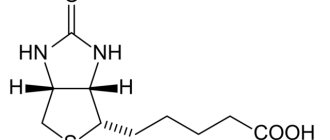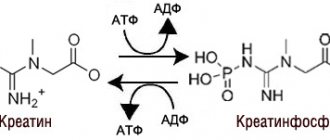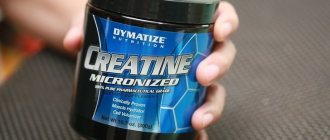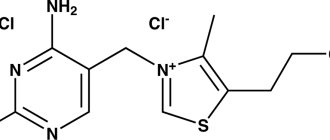Creatine phosphate is a source of explosive energy
Creatine is a substance of skeletal muscles, myocardium, and nervous tissue. In the form of creatine phosphate , creatine is a “depot” of high-energy bonds and is used for rapid resynthesis of ATP during cell function.
Use of creatine phosphate for ATP resynthesis
The role of creatine in muscle tissue is especially significant. Creatine phosphate ensures urgent resynthesis of ATP in the first seconds of work (5-10 sec), when no other energy sources (anaerobic glycolysis, aerobic oxidation of glucose, β-oxidation of fatty acids) are yet activated and the blood supply to the muscle is not increased. In nervous tissue cells, creatine phosphate maintains cell viability in the absence of oxygen.
During muscular work, Ca2+ ions released from the sarcoplasmic reticulum are activators of creatine kinase. The reaction is also interesting because in its example one can observe an inverse positive relationship - activation of the enzyme by the reaction product creatine . This avoids a decrease in the reaction rate during work, which would occur according to the law of mass action due to a decrease in the concentration of creatine phosphate in the working muscles.
About 3% of creatine phosphate is constantly converted to creatinine non-enzymatic . The amount of creatinine secreted healthy person per day is always almost the same and depends only on the volume of muscle mass. The level of creatine kinase activity in the blood and the concentration of creatinine in the blood and urine are valuable diagnostic indicators.
Formation of creatinine from creatine phosphate
Creatine synthesis
Creatine synthesis occurs sequentially in the kidneys and liver in two transferase reactions. After synthesis is completed, creatine is delivered through the bloodstream to the muscles or brain.
Reactions of creatine synthesis in the kidneys and liver
Here, in the presence of ATP energy (during rest or rest), it is phosphorylated to form creatine phosphate.
Creatine phosphate synthesis
If the synthesis of creatine outpaces the possibility of its fixation in muscle tissue, then creatinuria - the appearance of creatine in the urine. Physiological creatinuria is observed in the first years of a child’s life. Sometimes creatinuria in old people is classified as physiological, which occurs as a result of muscle atrophy and incomplete use of creatine formed in the liver. In diseases of the muscular system (myopathy or progressive muscular dystrophy), the highest concentrations of creatine are observed in the urine - pathological creatinuria.
0
https://youtu.be/V54EVgKi4Do
Determination of creatinine content in biological fluids
Task
1.
Determine the creatinine content in blood serum.
Principle.
Creatinine, when interacting with picric acid in an alkaline medium, forms an orange-red compound, the intensity of which is determined photometrically.
Progress.
Experimental sample -
add 0.5 ml of blood serum, 1 ml of distilled water and 0.5 ml of trichloroacetic acid;
calibration sample (reference) -
add 0.5 ml of calibration solution (creatinine concentration - 177 µmol/l), 1 ml of distilled water and 0.5 ml of trichloroacetic acid.
The contents of both tubes are mixed, left to stand for 5 minutes, then centrifuged at 2500-3000 rpm for 5 minutes. The supernatant liquid is poured off. Add 1 ml of supernatant liquid from each sample into two centrifuge tubes, add 0.5 ml of picric acid (0.04 mol/l) and 0.5 ml of NaOH (0.75 mol/l). Stir and measure exactly after 20 minutes in a 1 cm cuvette at 505 nm against the reference solution. Comparison solution: add 1.5 ml of distilled water and 0.5 ml of trichloroacetic acid into a centrifuge tube;
stir. 1 ml is taken from this solution and transferred to a separate test tube, 0.5 ml of picric acid and 0.5 ml of sodium hydroxide are added. The concentration of creatinine (X) in µmol/l in blood serum is calculated using the formula: X = (Set.×Eop.)/Eet., where Set. — creatinine concentration in the reference sample (177 µmol/l); Eop. — optical density of the test sample; Eet. — optical density of the reference sample. Normally, the creatinine content in blood serum (on an empty stomach) is: for men - 61-115 µmol/l, for women - 53-97 µmol/l.
Attention!
When working, you must strictly adhere to the rules for working with toxic substances in chemical laboratories, since picric acid is a poison, and trichloroacetic acid and NaOH are caustic substances!
Task
2.
Determine the creatinine content in urine.
Progress.
The determination is carried out in centrifuge tubes, which are filled in accordance with the scheme:
Urine diluted 1:100 (ml)
Trichloroacetic acid (ml)
Mix the contents of the tubes and measure the optical density of the test and calibration samples against the reference solution in a 1 cm cuvette at 505 nm exactly after 20 minutes. The reference (calibration) solution is prepared as in the case of determining creatinine in blood serum. The amount of creatinine (C) in mmol/day in urine is calculated using the formula:
U=(Set.×Eop.×D×50)/(Eet.×1000), where Set. — creatinine concentration in the reference sample (177 µmol/l); Eop. — optical density of the test sample; Eet. — optical density of the reference sample; D — daily diuresis (1.5 l); 1000 — conversion of µmol to mmol; 50 - urine dilution. Normal creatinine content in urine is: for men - 8.8-17.7 mmol/day (1.0-2.0 g); women - 7.1-15.9 mmol/day (0.8-1.8 g).
Clinical and diagnostic significance.
The concentration of creatinine in the blood serum of healthy people is relatively constant as a result of the strict relationship between its formation and excretion. Creatinine is a non-threshold substance; it is filtered only by the glomeruli, but is not reabsorbed. Secretion of creatinine by tubules is possible only when its concentration in the blood is high. The determination of creatinine to assess glomerular filtration is due to the fact that its concentration in plasma is inversely proportional to clearance under constant conditions of excretion and concentration. The critical upper limit is set to creatinine concentration at 115 µmol/l. Serum creatinine levels increase with retention azotemia. The degree of chronic renal failure is determined by the increase in its concentration in the blood. The amount of creatinine excreted in the urine directly depends on the phosphocreatinine content in the muscles. The amount of creatinine in urine will also vary depending on the creatinine content in food (there is a lot of it in meat products). Increased excretion of creatinine (hypercreatinuria) is accompanied by febrile conditions, acute infectious diseases, diabetes mellitus and diabetes insipidus. Creatinuria indicates a pathology of striated muscles (muscular dystrophy, atrophy, myasthenia gravis). Hypocreatinuria is observed in kidney diseases, namely in chronic nephritis, muscle atrophy, after infections, in old age and in nutritional dystrophy.
source
Pathologies in which creatinine is higher than normal
Elevated creatinine in the blood - what is it? This figure increases with uncontrolled sports activities. And also when performing physical exercises that help build muscle mass, high consumption of protein foods and taking certain medications (antibiotics, cephalosporins). In addition, the substance increases due to pathologies associated with metabolism in the body:
- radiation sickness;
- dehydration;
- various diseases of the endocrine system;
- renal failure;
- mechanical damage to muscle tissue or damage associated with surgical interventions.
We can talk about ill health only in cases of repeated excess of creatinine in the blood from the norm.
Diseases that doctors diagnose based on the results of biochemical analysis:
- Oncology. Metastases and malignant neoplasms destroy muscle tissue. There are forms of cancer in which serious changes occur in the liver and kidneys, which inevitably leads to an increase in creatinine.
- Injuries to muscle tissue. A natural metabolite is released from damaged muscles with extensive lesions. This indicator returns to normal during healing.
- Disorders related to the endocrine system. Excessive production of hormonal substances destroys muscle tissue, and as a result, creatinine increases. The danger lies in the fact that the disease is asymptomatic for a long time.
- Renal dysfunction. With certain pathologies, the organ fails to cope with its function, and harmful substances remain in the blood and are not excreted in urine. If the values are critical, the doctor prescribes a dialysis procedure for the patient.
- Heart failure. Heart muscle cells are destroyed and promote the release of creatinine, as a result of which it increases in the bloodstream.
- Nephrectomy. When one kidney is removed, the second takes on the entire load, and therefore the indicators can be increased.
Determination of creatine and creatinine content in blood serum
Creatine is an essential component of skeletal muscle tissue, heart, and brain. In the kidneys, liver and pancreas, which synthesize creatine, its content is low. In cells, creatine is involved in energy transfer in the form of creatine phosphate.
One of the breakdown products of creatine is creatinine, which is formed non-enzymatically.
Approximately 2% of the creatine contained in the body is converted into creatinine.
Determination of creatinine content in blood serum using the Lachema-biotest kit
Creatinine (42.5 mmol/l); albumin (solution 0.16 g/l); trichloroacetic acid (1.22 mol/l); picric acid (0.04 mol/l); sodium hydroxide (0.75 mol/l); reaction mixture (trichloroacetic acid solution 0.15 mol/l, picric acid 10.0 mol/l, sodium hydroxide 0.19 mol/l), serum/reaction mixture ratio 1:8.
Rack with test tubes, pipettes with a capacity of 1 and 2 ml, centrifuge, FEC.
The method is based on the interaction of creatinine in an alkaline medium with picric acid to form an orange-red color, the intensity is determined photometrically.
Add ingredients in the following quantities:
| Measure in ml | Experience | Control | Standard solution |
| Serum | 0,5 | — | — |
| Distilled water | 1,0 | 1,5 | 1,0 |
| Solution 3 | — | — | 0,5 |
| Reagent 3 | 0,5 | 0,5 | 0,5 |
Mix and centrifuge for 5-7 minutes at 3000 rpm.
| Reagent 4 | 0,50 | 0,50 | 0,50 |
| Reagent 5 | 0,50 | 0,50 | 0,50 |
Measure exactly after 20 minutes the optical density of the experiment (A1) and the standard (A2) against the control solution on FEC at a wavelength of 500-510 nm in a 1 cm cuvette.
Quantitative determination of creatine and creatinine
Reagents. Picric acid, saturated solution *; hydrochloric acid, 0.1 mol/l; Creatinine basic calibration solution * ; 12.5% sodium hydroxide solution.
Equipment. Rack with test tubes; pipettes at 0.2; 1.0; 2.0 and 5.0 ml; FEC; water bath.
Material. Test urine.
Principle of the method. It is based on the ability of creatinine in an alkaline environment with picric acid to form an orange complex, the intensity of which is proportional to the concentration of creatinine. Determination of creatine is carried out after converting it to creatinine by heating urine in a hydrochloric acid environment.
Progress of determination. Add 0.2 ml of concentrated hydrochloric acid into three labeled ordinary test tubes ( carefully, only with a pipette with a rubber bulb! ). Add 0.2 ml of test urine, previously diluted 5 times, to the 1st and 2nd test tubes: 1 tube is used to determine creatinine, 2 - creatine, 3 - control. Heat the second test tube for 5 minutes in a rapidly boiling water bath, then cool under running tap water. Add distilled water to all test tubes in the following quantities: the first test tube - 2.0 ml, the second - 2.0 ml, the third - 2.2 ml and add 0.6 ml of a saturated solution of picric acid and 1.0 ml to each test tube. 12.5% sodium hydroxide solution, mix thoroughly. Leave to stand for 10 minutes at room temperature, after which 6.0 ml of distilled water is added to all three test tubes. The optical density of the solutions under study was determined on a FEC with a wavelength of 507 nm in a cuvette at 10 m against a control sample (third tube). The amount was determined from the calibration graph.
What it is
Creatinine is the end product of creatine breakdown. The latter is involved in the energy metabolism of body tissues. Its blood readings will depend entirely on its formation and excretion.
Its concentration is also influenced by body weight, gender, age, presence of diseases, nutrition, and race. The rate is different for men and women. It constantly changes with age.
Basically, high creatinine indicates kidney failure, hormonal imbalances and organ diseases. Low levels are often observed in pregnant women and the elderly.
Symptoms
Symptoms of high concentrations of a chemical compound include:
- aching pain in the lower back;
- breathing problems;
- nausea and vomiting;
- loss of appetite;
- constant feeling of fatigue;
- weight loss;
- confused consciousness.
Swelling of the limbs and face, especially the eyelids, may also occur in the morning.
The performance of the substance in the body is affected by the functioning of the kidneys. When they fail, the concentration increases, as indicated by the following signs.
- Constant, possibly false, urge to go to the toilet. This could be diuresis. In this case, the person’s urine is not excreted from the body. Or, conversely, polyuria occurs. With this pathology, more than two liters of urine per day are excreted from the body.
- Aching, pulling pain in the lower back.
- Hypertension.
- Presence of edema.
In this case, the biochemical analysis will show not only high values, but also increased levels of urea or other components of residual nitrogen.
BHlabs / Determination of creatinine concentration
Determination of creatinine concentration in biological fluids by the kinetic method
Principle of the method:
The kinetic method without deproteination (protein precipitation) is based on the Jaffe color reaction. Creatinine in an alkaline environment forms a colored (orange) complex with picric acid.
The change in the optical density of a sample over a fixed time at a wavelength of 490-510 nm is directly proportional to the concentration of creatinine in it.
Linearity of the method: up to 1.33 mmol/l.
Blood serum – men – 53-97 µmol/l (25-37С);
women – 44-80 µmol/l (25-37С).
Daily urine – 88.5-133 mmol/l.
The concentration of creatinine remains stable in samples at a storage temperature of 2-8°C for 1 day.
Spectrophotometer with a thermostated cuvette, wavelength 490-510 nm, optical path length 1 cm; reaction temperature 25-37С;
Automatic pipettes for 50 µl, 250 µl and 1000 µl;
Blood serum/24-hour urine. Pre-dilute the urine with deionized water in a ratio of 1:50. In addition to serum, heparinized plasma can be used;
Reagent 1 (sodium hydroxide 160 mmol/l);
Reagent 2 (picric acid 4.0 mmol/l);
Standard (creatinine solution 177 µmol/l);
1. Sample (eg serum)
Mix the contents of the test tubes
Mix the contents of the test tube and start the stopwatch. Accurately after 60 seconds, measure the optical density of the experimental and standard samples against the blank sample at a wavelength of 490-510 nm (optical density A1). Repeat the measurement after 60 seconds (optical density A2). Calculate the change in optical density per minute for experimental and standard samples:
Calculation according to the standard of creatinine concentration in serum (plasma) is carried out according to the formula:
where Aop / st – change in optical density. in a minute;
Cst is the concentration of the standard.
Calculation of the standard for creatinine concentration in daily urine is carried out using the formula:
where Aop / st – change in optical density. in a minute;
Cst – standard concentration;
50 – dilution factor.
If the creatinine concentration exceeds 1.33 mmol/L (a point outside the linearity zone of the calibration graph), the analyzed sample (serum or urine) should be diluted 1:1 with saline and the measurement should be repeated, and the resulting calculation result should be multiplied by 2.
Icteric samples should not be analyzed because bilirubin will distort the measurements.
Clinical and diagnostic value:
Determination of creatinine concentration is carried out to study kidney function. When renal function deteriorates significantly, serum creatinine concentrations increase.
In healthy people, the concentration of creatinine in serum is relatively constant and depends little on gender, age, and diet, since the formation of creatinine in muscles as an end product of metabolism is relatively constant.
Endogenous creatinine clearance is used as a measure of glomerular filtration rate.
source
How is elevated creatinine treated?
Measures are taken to eliminate the cause. The patient is given intravenous medications - sorbents and diuretics, which increase diuresis and help the kidneys excrete this substance. Such manipulations are effective provided that the urinary system functions normally and exogenous or endogenous creatinine enters the blood. In case of renal failure, hemodialysis is prescribed. In this case, the blood is purified using a special “artificial kidney” device in a hospital setting. This procedure is carried out three times a week.
Traditional medicine also offers several ways to reduce creatinine. The use of medicinal herbs is possible provided that kidney function is normal. Teas are brewed from herbs that have a diuretic effect: sage and nettle leaves; from dandelion roots. Daily intake of drinks activates the kidneys and stimulates increased secretion of urine, and, accordingly, creatinine. Before you begin to reduce it, you should consult a doctor to determine treatment tactics.
Causes of hypocreatinemia
Deviation of creatinine in urine from the norm towards a decrease is quite rare. The reason lies in the disruption of protein metabolic processes or problems in the functioning of the muscular system. In these cases, kidney function is not impaired. Severe exhaustion of the body leads to the fact that creatinine from muscle tissue is spent to replenish the body's energy reserves.
Reasons for low concentration:
- cachexia caused by hunger or chronic diseases;
- vegetarianism;
- insufficient nutrition in combination with increased physical activity and, as a result, a sharp decrease in body weight;
- dystrophy;
- atrophy;
- taking glucocorticoids;
- pregnancy.
Thus, the main problem of hypocreatinemia lies in the exhaustion of the body. What does creatinine do? It is involved in energy metabolism, so to restore the indicator to normal it is necessary to eliminate the immediate cause.
The concentration of this substance in the blood at a certain acceptable level is maintained due to the normal functioning of the kidneys. What does a biochemical blood test for creatinine show? Fluctuations in one direction or another indicate disturbances in the functioning of the kidneys.
Preparing for a urine creatinine test
Three days before the study you should exclude: coffee, carbonated and alcohol-containing drinks. In food, give preference to lean foods. If you are taking hormonal medications, you should inform your doctor in advance, as the results may be distorted.
For analysis, morning urine is taken before meals. To diagnose kidney diseases, the protein-creatinine ratio is determined in a single portion of urine.










